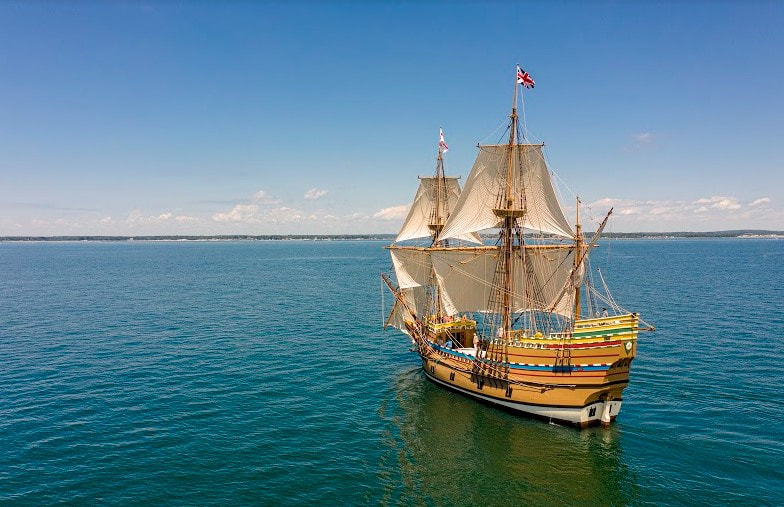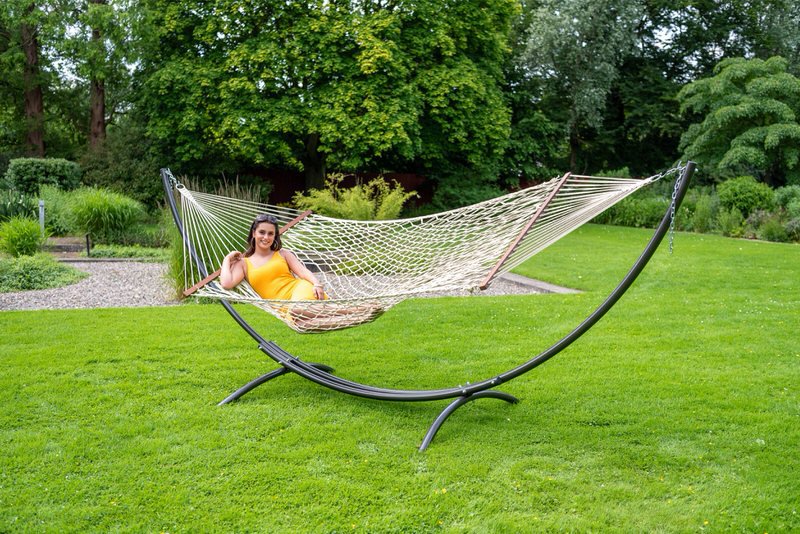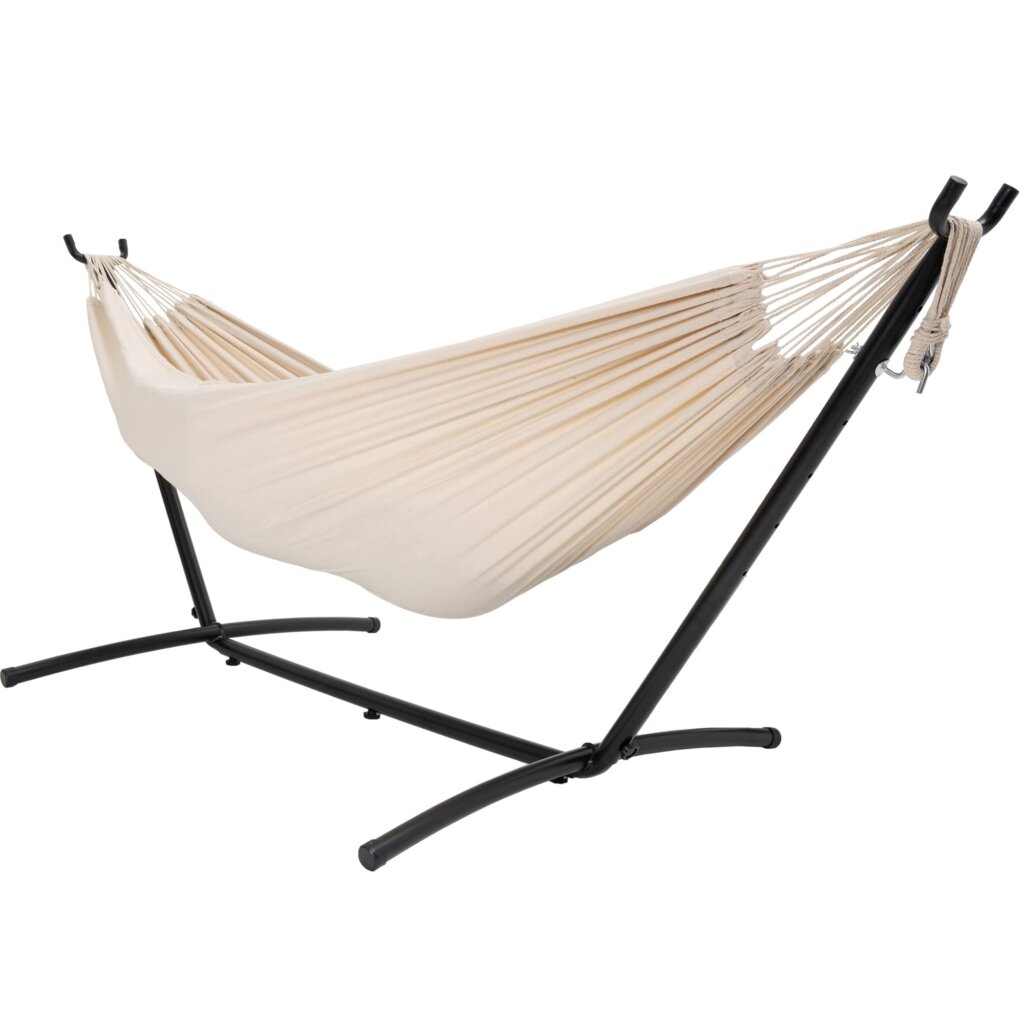- 8 Airplane Footrest Hammock!Travel comfortably - October 9, 2023
- top 7 Pool Float Water Hammock for a Relaxing Summer - October 9, 2023
- top 5 Space SaverSingle Hammock Stand Maximize Comfort and Space - October 9, 2023
Sailors often slept in hammocks on ships for comfort and space maximization.Sailing the high seas has always been an adventure fraught with challenges and camaraderie. Among the many elements that defined the seafaring life, one often overlooked but integral aspect was the sailor’s bed—the humble hammock.
This article delves into the intriguing history of how sailors of old found rest and comfort while aboard their vessels, suspended above the ocean waves.
Evolution Of Sleeping Conditions On Ships
Historical perspective on sailors’ sleeping conditions
The sleeping conditions on ships have evolved significantly throughout history, influenced by various factors such as available space, comfort, and practicality for sailors. In the early days, sailors had to sleep on the wet, hard, and dirty decks, which often led to discomfort and health issues. As maritime exploration advanced, the need for better sleeping arrangements became evident.
Introduction of hammocks as a solution
One of the solutions introduced for sailors’ sleeping conditions was the introduction of hammocks. Hammocks gained popularity due to their practicality and ability to maximize available space on ships. The use of hammocks enabled sailors to sleep comfortably above the deck, away from the dampness and dirt.
Reasons for the popularity of hammocks among sailors
There were several reasons why hammocks became popular among sailors. Firstly, hammocks swayed and rocked with the ship’s movements, which helped sailors adjust to the constant motion of the sea and sleep better. This rocking motion aided in reducing seasickness and provided a sense of comfort and stability.
Secondly, hammocks were a more hygienic option compared to sleeping directly on the ship’s deck. They elevated sailors above the dirty and wet surfaces, reducing the risk of contracting diseases and infections. Additionally, hammocks were easier to clean and maintain compared to the deck itself.
Lastly, hammocks allowed for efficient utilization of space on ships. As ships became more crowded with crew and supplies, maximizing available space became crucial. Suspended hammocks allowed sailors to occupy vertical space, leaving the deck clear for other activities and storage.
Advantages Of Sleeping In Hammocks
Advantages of Sleeping in Hammocks
Comfort and support provided by hammocks
One of the main advantages of sleeping in hammocks is the comfort and support they provide. Unlike traditional beds, hammocks contour to the shape of the body, allowing for proper alignment of the spine and reducing pressure points. The gentle swaying motion of a hammock can also help to lull sailors into a deeper and more restful sleep. The ergonomic design of hammocks ensures sailors wake up feeling refreshed and free from aches and pains.
Practicality and efficiency of hammocks in limited spaces
For sailors living on ships with limited space, hammocks offer a practical and efficient sleeping solution. Hammocks can be easily suspended from the walls or ceilings of a ship, maximizing the available space and allowing for efficient use of berth decks and sleeping quarters. In contrast, traditional beds require more floor space and can be cumbersome to move or store. This makes hammocks the ideal choice for sailors who need to make the most of their limited living areas while ensuring a comfortable and restful sleep.
Improved sleep quality and reduced fatigue for sailors
Sleep is crucial for sailors, as they often work long hours and need to be alert and attentive to their duties. Sleeping in hammocks has been shown to improve sleep quality and reduce fatigue. The gentle rocking motion of a hammock simulates the feeling of being cradled, promoting relaxation and faster onset of sleep. It also helps sailors to stay asleep longer, undisturbed by the movements and vibrations of the ship. By ensuring sailors get a good night’s sleep, hammocks contribute to their overall well-being and ensure they are ready to perform their tasks at their best.
The Science Behind Hammock Sleeping
The Science Behind Hammock Sleeping
When it comes to sailors and their preferred method of sleeping, hammocks have played a fascinating role throughout history. But what is the science behind hammock sleeping and why did sailors choose this unconventional sleep surface? In this article, we’ll explore the various aspects that make hammocks unique and delve into the reasons why sailors embraced this sleeping solution.
How Hammocks Promote Better Sleep
Hammocks have long been hailed as a sleep solution that promotes better sleep and relaxation. The unique design and comfort features of hammocks offer several benefits that contribute to improved sleep quality:
- Hammocks envelop the body in a gentle cradle, providing a natural curvature support to the spine, leading to proper alignment and reduced pressure points.
- The hammock’s rocking motion helps induce sleep faster by mimicking the soothing movement experienced in the womb.
- Compared to traditional beds, hammocks distribute weight evenly, relieving stress on specific body parts and aiding in overall muscle relaxation.
- The breathable fabric of hammocks allows for better airflow, preventing overheating during sleep and creating a cool sleep environment.
Ergonomic Benefits of Hammocks
Aside from the sleep benefits, using hammocks also offers numerous ergonomic advantages. Here are some key features that contribute to the hammock’s ergonomic benefits:
- Hammocks provide a natural curvature to the body, promoting proper spinal alignment and reducing the risk of developing back pain.
- The suspended position of hammocks takes pressure off joints, minimizing stress and strain on the body and reducing the likelihood of joint or muscle pain.
- The swinging motion of hammocks can stimulate the vestibular system, enhancing balance and coordination.
- The gentle rocking sensation aids in stress reduction and relaxation, promoting a deeper and more restful sleep experience.
Impact on Sailors’ Physical Health and Overall Well-Being
For sailors, the choice of hammocks as their sleeping surface had a significant impact on their physical health and overall well-being. Sleeping in hammocks provided sailors with the following benefits:
- The swaying movement of the hammock helped offset the rocking and rolling motion of the ship, reducing the chances of seasickness and allowing sailors to rest better during rough seas.
- Hammocks saved space on ships, as they could be easily rolled up and stored away when not in use, providing sailors with more living space on board.
- The use of hammocks improved hygiene conditions, as they were kept above the damp and dirty decks, reducing the risk of contracting illnesses and infections.
- The ergonomic support offered by hammocks prevented sailors from developing musculoskeletal issues, ensuring their physical health was maintained even during long voyages.
- The superior comfort provided by hammocks contributed to sailors’ overall well-being, allowing them to recuperate and recharge more effectively, ultimately enhancing their performance on board.
In conclusion, the science behind hammock sleeping reveals a multitude of benefits that make it an ideal choice for sailors. From promoting better sleep and providing ergonomic support to positively impacting physical health and overall well-being, hammocks have proven to be a practical and effective sleep solution for those navigating the high seas.
Cultural Significance Of Hammocks On The High Seas
Traditions and rituals associated with hammocks in maritime cultures
Throughout maritime history, hammocks have played a vital role in the traditions and rituals of seafaring cultures. Aboard ship, hammocks were regularly employed for sailors sleeping on the gun decks of warships. The use of hammocks not only provided a practical solution to limited space and comfort but also became deeply ingrained in the daily routines and customs of sailors.
Symbolism and camaraderie fostered through hammock use
In maritime cultures, the symbolism and camaraderie fostered through the use of hammocks created a sense of community among sailors. Hammocks were shared sleeping spaces, with sailors often sleeping in close proximity to their shipmates. This close-quarters living not only facilitated a bond between sailors but also allowed for a culture of mutual support and closeness.
Influence of hammocks on sailors’ sense of identity and community
The use of hammocks among sailors played a significant role in shaping their sense of identity and community at sea. The reliance on hammocks as a preferred sleeping accommodation created a unique subculture within maritime communities. Sailors formed strong bonds with their hammocks, often personalizing them with mementos, talismans, or embroidery to reflect their individuality and establish a sense of ownership.
This sense of identity and community extended beyond personalization. Hammocks became a symbol of a sailor’s status and experience, with seasoned sailors often having hammocks positioned in the most coveted spaces within the ship. The hierarchy within maritime communities could be reflected in the positioning of hammocks, further reinforcing the importance and influence of hammocks on sailors’ sense of identity at sea.
Controversies Surrounding Hammock Sleeping
Sleeping in hammocks has long been a tradition among sailors at sea. However, this sleeping arrangement has not been without its fair share of controversies. In this blog post, we will explore the criticisms of hammocks as a sleeping solution for sailors, as well as the counterarguments and defenses of hammock usage. We will also delve into instances of sailors transitioning away from hammocks.
Criticisms of Hammocks as a Sleeping Solution for Sailors
Despite being a common practice among sailors, hammocks have faced criticism as a sleeping solution. Some of the main criticisms include:
- The lack of stability: Hammocks are known for their swaying and rocking motion, which can be unsettling for some individuals. This lack of stability has led to complaints of disrupted sleep and discomfort.
- Space constraints: While hammocks are known for maximizing available space on ships, they can also be limiting in terms of personal space. Some sailors find it difficult to find a comfortable position or have enough room for personal belongings.
- Inadequate support: Hammocks, especially those made from lightweight materials, may not provide the same level of support as a traditional mattress. This can lead to issues such as back pain and muscle stiffness.
Counterarguments and Defenses of Hammock Usage
Despite the criticisms, hammocks have their defenders, and there are several counterarguments in favor of hammock usage:
- Improved sleep quality: For many sailors, the gentle swaying motion of a hammock actually helps lull them into a deeper sleep. This movement mimics the motion of a ship at sea, providing a sense of familiarity and comfort.
- Hygiene and cleanliness: Sleeping in a hammock keeps sailors off the wet, hard, and dirty deck of a ship. Hammocks elevate sailors above the potential hazards and allow for better airflow, reducing the risk of skin irritations and infections.
- Economy and space-saving: Hammocks are a practical solution for ships with limited space. They can be easily stored away when not in use, freeing up valuable space for other activities.
Instances of Sailors Transitioning Away from Hammocks
While hammocks have been a staple sleeping solution for sailors, there have been instances where sailors transitioned away from hammocks:
| Sailor Transition | Reason |
|---|---|
| Sailor X | The sailor experienced frequent back pain and found it difficult to find a comfortable position in a hammock. |
| Sailor Y | The sailor preferred the stability and support of a traditional mattress, which resulted in better sleep quality. |
| Sailor Z | The ship’s design changed, providing individual cabins with enough space for standard beds. |
Overall, the controversies surrounding hammock sleeping for sailors highlight the personal preferences, physical considerations, and practical limitations of this sleeping arrangement. While some sailors swear by their hammocks, others may find alternatives that better suit their needs.

Credit: www.hrmm.org
Modern Adaptations And Innovations In Hammock Design
Technological advancements in hammock materials and construction
Modern advancements in technology have revolutionized hammock design, making them more durable, comfortable, and versatile than ever before. Hammock companies have embraced cutting-edge materials and construction techniques to create hammocks that can withstand the rigors of sailing and provide optimal comfort to sailors during their much-needed rest.
Customizations and adjustments made for specific sailing conditions
To ensure that hammocks meet the unique needs of sailors, there are various customizations and adjustments made for specific sailing conditions. These include:
- Weather-resistant materials: Hammocks are now made with weather-resistant materials such as nylon or polyester, which can withstand harsh elements at sea. This allows sailors to use hammocks in various weather conditions without worrying about damage or deterioration.
- Integrated bug netting: Sailing in tropical areas often means dealing with pesky insects. Many modern hammocks come with integrated bug netting, providing sailors with protection from mosquitoes and other bugs while they sleep.
- Adjustable suspension systems: Hammocks now feature adjustable suspension systems, allowing sailors to easily hang their hammocks at the desired height and tension. This ensures maximum comfort and support, tailored to individual preferences.
- Compact and lightweight designs: Sailors have limited storage space on ships, so modern hammocks are designed to be compact and lightweight. This makes them easy to pack and transport, without adding unnecessary bulk to a sailor’s gear.
Integration of hammocks into contemporary maritime practices
Hammocks have become an integral part of contemporary maritime practices, enhancing sailors’ experience at sea. Here are some examples of how hammocks are integrated into modern sailing:
| Practice | Description |
|---|---|
| Naval vessels | In naval vessels, hammocks are still used by sailors for sleeping on the gun decks. This tradition harkens back to the days when sailors slept in hammocks to save space and provide a comfortable resting place. |
| Recreational boating | Not just limited to naval vessels, hammocks have found their way into recreational boating as well. Sailors and boaters now enjoy the relaxation and comfort of hammocks while anchored or taking a break during their journey. |
| Adventure sailing | In adventure sailing, hammocks have become a staple for those seeking unique and immersive experiences on the open water. The gentle sway of a hammock provides a tranquil and soothing escape from the demands of sailing. |
| Crew accommodations | Some modern sailing vessels are designed with specific hammock setups to accommodate crew members. This ensures that sailors have a dedicated and comfortable sleeping area while at sea. |
These advancements and adaptations in hammock design have not only preserved the historical significance of sailors sleeping in hammocks but have also elevated their practicality and comfort for modern-day sailors. Whether on naval vessels or recreational boats, hammocks continue to play a vital role in ensuring well-rested and content sailors during their voyages.
Frequently Asked Questions On Did Sailors Sleep In Hammocks
Why Did The Navy Stop Using Hammocks?
The Navy stopped using hammocks because beds are more comfortable and easier to get in and out of.
Why Did Pirates Sleep In Hammocks?
Pirates slept in hammocks because it was easier for them to sleep and they swayed with the ship’s movements.
Did They Use Hammocks On Ships?
Yes, sailors used hammocks on ships for sleeping. Hammocks provided comfort and saved space on the crowded decks of ships.
What Did Sailors Sleep In?
Sailors slept in hammocks on their ships because it was more comfortable and allowed them to sleep peacefully. Hammocks swayed and rocked with the ship’s movements, making it easier for sailors to rest. This also maximized the available space on the ship.
Why Did Sailors Sleep In Hammocks On Their Ships For Many Years?
Sailors slept in hammocks on their ships for many years because hammocks provided a comfortable sleeping arrangement, allowed for better air circulation, and saved space on the ships.
Did Sailors Sleep In Hammocks On Pirate Ships Too?
Yes, sailors on pirate ships also slept in hammocks. Hammocks were a practical sleeping solution for sailors as they rocked with the ship’s movements and were easy to set up and store.
Conclusion
Sleeping in hammocks was a common practice for sailors on ships for many reasons. It provided a comfortable and secure sleeping arrangement, especially in rough seas. Hammocks also maximized space on the ship and were more hygienic than sleeping on the hard, dirty deck.
Additionally, the gentle swaying motion of the hammocks helped sailors sleep more peacefully. Overall, the use of hammocks on ships proved to be a practical and advantageous choice for sailors throughout history.





